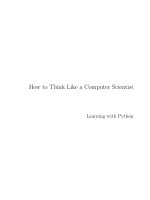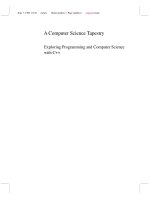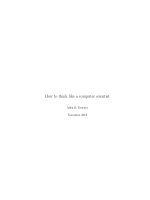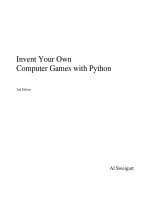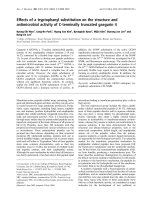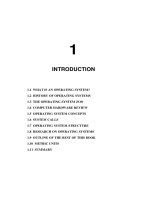Owen l astrachan a computer science tapestry exploring programming and computer science with c++ 2nd
Bạn đang xem bản rút gọn của tài liệu. Xem và tải ngay bản đầy đủ của tài liệu tại đây (4.37 MB, 879 trang )
June 7, 1999 10:10 owltex Sheet number 1 Page number i magenta black
A Computer Science Tapestry
Exploring Programming and Computer Science
with C++
June 7, 1999 10:10 owltex Sheet number 2 Page number ii magenta black
ii
A Computer Science Tapestry
Exploring Programming and Computer Science
with C++
Second Edition
Owen L. Astrachan
Duke University
Boston Burr Ridge,IL Dubuque,IA Madison,WI New York San Francisco St. Louis
Bankok Bogotá Caracas Lisbon London Madrid
Mexico City Milan New Delhi Seoul Singapore Sydney Taipei Toronto
June 7, 1999 10:10 owltex Sheet number 3 Page number iii magenta black
iii
Front matter
June 7, 1999 10:10 owltex Sheet number 4 Page number iv magenta black
iv
Copyright information
June 7, 1999 10:10 owltex Sheet number 5 Page number v magenta black
v
About theAuthor
Owen L. Astrachan is Associate Professor of the Practice of Computer Science at Duke
University and the department’s Director of Undergraduate Studies for Teaching and
Learning. After receiving his A. B. degree from Dartmouth College, he taught high
school for seven years before returning to graduate school. He received his Ph.D. in
Computer Science from Duke in 1992. Professor Astrachan was a member of the Duke
programming team that placed fourth in the world in the ACM programming contest
in 1989 and coached the third place team in 1994. He was the chief Reader for the
Advanced Placement Computer Science Exam from 1990 to 1994. Professor Astra-
chan has written many technical and pedagogical articles and has been the Principal
Investigator inthree NSF-sponsored educational projects: “The AppliedApprenticeship
Approach: An Object-Oriented/Object-Based Framework for CS2,” “CURIOUS: Cen-
ter for Undergraduate Education and Research: Integration through Performance and
Visualization,” and “Using and Developing Design Patterns.” A well-regarded teacher,
Professor Astrachanreceived the 1995Robert B.Cox Distinguished Teachingin Science
Award.
June 7, 1999 10:10 owltex Sheet number 6 Page number vi magenta black
vi
To my teachers, colleagues, and friends, especially to those who are all three, for
educating, arguing, laughing, and helping.
To Laura and Ethan
June 7, 1999 10:10 owltex Sheet number 7 Page number vii magenta black
Preface
TheTapestryViewed fromAfar
Thisbookisdesignedforafirstcourse
1
incomputersciencethatusesC++asthelanguage
by which programming is studied. My goal in writing the book has not been to cover
the syntax of a large language like C++, but to leverage the best features of the language
using sound practices of programming and pedagogy in the study of computer science
and software design. My intentisthat mastering thematerialpresentedhere will provide:
A strong grounding in the analysis, construction, and design of programs and
programming.
A means for honing problem-solving skills associated with the study of computer
programming and a taste of both the science and engineering aspects of program-
ming.
An introduction to computer science that gives thestudent more of an idea of what
the discipline is about than most introductory programming texts.
In particular, this is a book designed to teach programming using C++, not a book de-
signed to teach C++. Nevertheless, I expect students who use this book will become
reasonably adept C++ programmers. Object-oriented programming is not a program-
mer’s panacea, although it canmake somejobs much easier. To mix metaphors, learning
to program is a hard task, no matter how you slice it—it takes time to master, just as
bread takes time to rise.
The material here is grounded in the concept that the study of computer science
should be part of the study of programming. I also want students to use classes before
writing them, so a library of useful classes is integrated into the text. Students will
better appreciate good design by seeing it in practice than by simply reading about
it. This requires studying and using classes that actually do something and that are
easy for novice programmers to use. For example, I don’t use any examples about
bank accounts or Automated Teller Machines. These traditional examples work well in
explaining concepts, but it’s not possible to implement a real bank account class or an
ATM in thefirst programming course. I do supply classes for calendar dates, unbounded
integers, timing program segments, reading directories, random numbers, and several
others. These classes can be used early (or late) in a semester, allowing students to write
more interesting programs without writing more code. For example, using the Date
class students can write a three-line program to determine how many days old they are
whenever they run the program, an eight-line program to find out whatday Thanksgiving
falls on in any year, and a forty-line program to print a calendar for any year. Using
1
This first course has traditionally been called CS1 after early ACM guidelines.
vii
June 7, 1999 10:10 owltex Sheet number 8 Page number viii magenta black
viii
the classes for reading directories makes it possible to write a twenty-line program for
finding all filesthat are large, or werelast modified yesterday, ora host ofother problems.
Most importantly, this book takes the view that the study of computer science should
involve hands-on activity and be fun. The study of programming must cover those areas
that are acknowledged as fundamental to computer science, but the foundation that is
constructedduringthis study must be solid enough to supportcontinuedstudyofarapidly
changing programming world, and the process of studying should make students want
to learn more. Support for this position can be found in several places; I offer two quotes
that express my sentiments quite well.
Having surveyed the relationships of computer science with other disciplines, it
remains to answer the basic questions: What is the central core of the subject?
What is it that distinguishes it from the separate subjects with which it is related?
What is the linking thread which gathers these disparate branches into a single
discipline? My answer to these questions is simple—it is the art of programming
a computer. It is the art of designing efficient and elegant methods of getting
a computer to solve problems, theoretical or practical, small or large, simple or
complex. It is the art of translating this design into an effective and accurate
computer program. This is the art that must be mastered by a practising computer
scientist; the skill that is sought by numerous advertisements in the general and
technicalpress; theabilitythatmustbefosteredanddevelopedbycomputerscience
courses in universities.
C. A. R. Hoare
Computer Science (reprinted in [Hoa89])
A supporting view is expressed in the following quote:
Programming is unquestionably the central topic of computing.
In addition to being important, programming is an enormously exciting in-
tellectual activity. In its purest form, it is the systematic mastery of complexity.
For some problems, the complexity is akin to that associated with designing a fine
mechanical watch, i.e., discovering the best way to assemble a relatively small
number of pieces into a harmonious and efficient mechanism. For other problems,
the complexity is more akin to that associated with putting a man on the moon,
i.e., managing a massive amount of detail.
In addition to being important and intellectually challenging, programming is
a great deal of fun. Programmers get to build things and see them work. What
could be more satisfying?
John V. Guttag
Why Programming Is Too Hard and What to Do about It in [MGRS91]
Programming and Computer Science
This is more than a book about programming. Although its principal focus is on pro-
gramming using C++, this is also a book about computer science. However, this is
June 7, 1999 10:10 owltex Sheet number 9 Page number ix magenta black
ix
neither a book that adopts what some have called a breadth-first approach to computer
science, nor is it a book whose only purpose is to teach object-oriented programming in
the first course (although glimpses of both approaches will be evident).
Introductory courses are evolving to take advantage of new and current trends in
software engineering and programming language design, specifically object-oriented
design and programming. Some schools will adopt the approach that learning object-
oriented design principles should be the focus of a first programming course. Although
this approach certainly has some merit, students in the first course traditionally have
a very difficult time with the design of loops, functions, and programs. I believe that
attempting tocover object-orienteddesign inaddition to these other designskills willnot
be as conducive to a successful programming experience as will using object-oriented
concepts in the contextoflearning to program byreading andusing classesbefore writing
them. This may seem a subtle distinction, but if the focus of the course is on learning
about the design and use of objects, there may be a tendency to delve too quickly and
too deeply into the details of C++.
The approach taken in this book is that C++ and OOP permit students with little
or no programming background to make great strides toward developing foundational
knowledge and expertise in programming. In subsequent courses students will hone the
skills that are first learned in the study of the material in this book and will expand the
coverage of computer science begun here. Computer science is not just programming,
and students in a first course in computer science must be shown something of what the
discipline is about. At the same time, programming provides a means of relating the
subdisciplines that compose compter science. Many of the examples and programs in
this book rely on classes, code, and libraries that are documented and supplied with the
book.
A major tenet of the approach used here is that students should read, modify, and
extend programs inconjunction with designingand writing fromscratch. This isenabled
to a large extent by using the object-oriented features of C++ whenever appropriate. I
view C++ as a tool to be used rather than studied. One of the most important ideas
underlying the use of classesand objects in C++, andone of the most importantconcepts
in computer science, is the idea of abstraction.
Its [computer science’s] study involves development of the ability to abstract the
essential features of a problem and its solution, to reason effectively in the abstract
plane, without confusion by a mass of highly relevant detail. The abstraction must
then be related to the detailed characteristics of computers as the design of the
solution progresses; and it must culminate in a program in which all the detail
has been made explicit; and at this stage, the utmost care must be exercised to
ensure a very high degree of accuracy. … The need for abstract thought together
with meticulous accuracy, the need for imaginative speculation in the search for a
solution, together with a sound knowledge of the practical limitations of the tools
available for its implementation, the combination of formal rigour with a clear
style for its explanation to others—these are the combinations of attributes which
should be inculcated and developed in a student … and which must be developed
in high degree in students of computer science.
C. A. R. Hoare (reprinted in [Hoa89])
June 7, 1999 10:10 owltex Sheet number 10 Page number x magenta black
x
Students and teachers of computer science are not obliged to understand the IEEE
standards for floating-point numbers in order to write code that uses such numbers. Al-
though at one time a deep understanding of machine architecture was necessary in order
to write programs, this is no longer the case. Just as Hoare exhorts the programmer to be
articulate about his or her activity, this book is designed to bring the novice programmer
and student of computer science and program design to a point where such behavior is
possible. The use of C++ provides a mechanism for doing so in which details can be
revealed if and when it is appropriate to do so and hidden otherwise.
Programming in C++
Although this book uses C++ as a tool to be used rather than studied, students coming
out of a first course must be well prepared for subsequent courses in computer science
and other disciplines. Therefore, the essential features of C++ must be used, studied,
and mastered. The syntactic and semantic features of C++ sufficient for an introductory
course are thoroughly covered. At Duke, we teach our first courses using C++, and then
we move to Java. We have had great success with this approach. This book uses C++,
not C. In particular, there is no coverage of I/O using printf and scanf, there is no
coverage of C-style (char *) strings, and the coverage of C-style arrays is minimal and
included only because initializing an array with several values shortens code. Instead,
we use streams for I/O, the standard C++ class string, and a modification of the STL
vector class called tvector that performs range-checking on all vector accesses.
Many thought and programming exercises are integrated in the text, particularly in
the pause and reflect sections. These exercises are designed to make students think
about what they’re doing and to cover some of the messier language details in thought-
provoking and interesting ways. On-line materials accessible via the World Wide Web
provide supporting programming lab assignments.
A CloserView of the CSTapestry
This book is different from most other introductory programming contexts in several
ways:
Functions are introduced very early, but in a natural way that makes programming
with functions easier than without.
Strings are used before ints or doubles, though all are introduced early in the text
so that numerical examples can be mixed with text and string examples.
Whenever possible, thecomputer is exploited—small programs do not necessarily
equate with toy programs. The classes included in the text make this possible.
A large number of classes, programs, and libraries are supplied with the book.
Students will use the classes first, studying only their interfaces, before delving
into implementation and design issues.
Features of C++ that simplify programming are used, but not all features of C++
are emphasized. For example, since we use string and vector classes rather than
June 7, 1999 10:10 owltex Sheet number 11 Page number xi magenta black
xi
pointer-based C-style objects, there is no reason to cover copy constructors or as-
signment operators. These topics are covered in the text, but there’s no compelling
reason to cover them.
How to Use the Book
I do not cover every section of the book in my courses, and instructors who used the first
edition indicated that they skip some sections as well. I’ll provide an overview of how
chapters can be covered, but the best recommendations will be your own after looking
at the material. I’ll also post sample syllabi on the book’s web site as people using the
book send the syllabi to me.
The How to Sections
The Howto sectionsare new to thissecond edition. One ofthe commoncomplaints from
users of the first edition was that it was not an ideal reference. Material on language-
specific features of C++ was introduced as needed so that related material was not
always found together. To address this valid concern, I have created How to sections
that condense C++ specific topics into a series of appendices, making it easier to use the
book as a reference as well as a textbook. The How to sections are referenced in the text
by a flyingcarpeticonas shown to theleft, withthe relevant How to referenced inthetext.
For example, How to B provides detailed information on using streams and formatting
output. By including the material in the How to appendix, it can be found quickly and it
doesn’t clutter a more general discussion of computer science and programming design
with C++ specifics.
Chapter Coverage and Dependencies
Chapter 1 is an overview of computer science and programming. None of the material
is used in subsequent chapters, though covering Chapter 1 doesn’t take much time and
sets a tone for using the book.
Part 1: Foundations of C++ Programming
Chapters 2 through 5 cover material essential to what is covered in the rest of the text.
However certain sections in this part can be skipped or treated less thoroughly since the
material is repeated in other contexts later. The Balloon class used in Section 3.4
introduces a simple and compelling class, but the section can be skipped since the
material on classes is studied again in Section 5.4. It’s also possible to cover all the
control statements early, then use the examples and classes introduced in Chapters 2
through 5. Chapters 2 through 5 should take less time to cover than Chapters 6 through
8. In general, the chapters later in the book take more time to digest than the earlier
chapters, but offer more material.
June 7, 1999 10:10 owltex Sheet number 12 Page number xii magenta black
xii
Part 2: Program and Class Construction: Extending the Foun-
dation
The material in Chapters 6through 8, combinedwith earlier material, will form the basis
of many first courses. It’s possible to use sections of chapters from Part 3 to augment
the material in the first eight chapters as noted below.
For those who prefer to cover vectors early, it’s possible to cover Sections 6.1, 6.2
and 7.4, thencover Chapter 8. The material inSection8.4on built-in arrays iscompletely
optional. The class tvector is modeled after the STL class vector, but performs
range-checking for theoverloaded indexing operator. The discussionof tvector relies
on the method push_back for adding elements to a vector so that the vector resizes
itself as needed. The differences between size and capacity for vectors are emphasized
in Chapter 8.
The class WordStreamIterator introduced in Section 6.3 can be omitted each
time it’s used, though it’s much easier to use the class to read a file more than once
within the same program than using the stream functions described in How to B to reset
a stream. The material on sets of strings in Section 6.5 is used in later chapters, but it
can be skippedeach time it’s covered. The random walk classes discussed in Section 7.3
can be skipped, though they’re used later in discussing inheritance and pointers.
Part 3: Design,Use,andAnalysis: Building on the Foundation
Chapters 9 through 13 provide a wealth of material. It’s unlikely that all the chapters
can be covered in a single semester.
In general, most of the chapters in this part are independent of each other, though not
completely. The material in Chapter 13 can be covered early, though it uses pointers.
A quick discussion of allocation using new can finesse the use of pointers since the
pointers are used to store vectors of elements in an inheritance hierarchy, not for linked
structures.
Chapter 9, which covers getline, string streams, and overloaded operators, and
Chapter 10 on recursion, can be covered in any order. Most of the material is not used
in subsequent chapters, though the getline function is used in several examples and
recursion is used in quick sort. These chapters could be covered before Chapter 8 on
vectors except that the example ofrecursion inSection 10.3.3 that permutes the elements
in a vector. The material on immutable lists in Section 10.5 can be skipped though it is
used in a few examples in later chapters.
Most of material in Chapter 11 can be skipped entirely or covered immediately after
covering vectors. Section 11.3 on function objects is optional, though it’s the right way
of sorting by several criteria and function objects are important in the STL and the Java
Collections classes.
Thanks
Many people have contributed to this book and the material in it, and I hope that many
more will. I must single out several people who have offered criticisms and suggestions
June 7, 1999 10:10 owltex Sheet number 13 Page number xiii magenta black
xiii
that have been extremely useful during the development of this project: Rich Pattis
(Carnegie Mellon University) and Dave Reed (Dickinson College). At Duke, Susan
Rodger taught using a draft of the first edition, waited patiently while chapters were
revised, and offered a nearly uncountable number of exercises, improvements, and pro-
grams. Her efforts have been very important in the development of this material. Greg
Badros (then at Duke)reviewedthe entire manuscript ofthe firstedition andofferedabso-
lutely wonderful suggestions; he astonished me with his perspicacity. In the fall of 1995
David Levine used the first edition at Gettysburg College and made many constructive
suggestions basedon this use. Inthe fall of1996 Dee Rammlearned andtaught using the
final draft, and made many useful suggestions. Through the auspices of McGraw-Hill,
Marjorie Anderson offered wonderful suggestions for improving the quality of the first
edition. Although I haven’t vanquished the passive voice, any progress is due to her
diligence, and all stylistic blunders are my own. Among the users of the first edition,
Beth Katz at Millersville University stands out for providing feedback that I’ve tried to
incorporate into this second edition.
The folks from McGraw-Hill involved with the second edition have been absolutely
wonderful. Betsy Jones, Emily Gray, and Amy Hill have helped with time, patience, and
support throughout the development of the second edition. John Rogosichat Techsetters
created L
A
T
E
X macros and supplied support for those macros with great alacrity. Pat
Anton was my contact about the artwork at Techsetters; if it looks good it’s due to her,
and if it doesn’t it’s because I originated it all.
In addition, the following peoplehave reviewed thematerial andoffered many useful
suggestions both for the first edition and for this second edition (if I’ve left someone
out, I apologize): Robert Anderson, Deganit Armon, John Barr, Gail Chapman, Mike
Clancy,RobertDuvall, ArthurFarley,SarahFix, DonaldGotterbarn, KarenHay,Andrew
Holey, Judy Hromcik, Beth Katz, David Kay, Joe Kmoch, Sharon Lee, Henry Leitner,
DavidLevine, ClaytonLewis, John McGrew, JerryMead, Judy Mullins, DavidMutchler,
Richard Nau, Jeff Naughton, Chris Nevison, Bob Noonan, Richard Pattis, RobertPlantz,
Richard Prosl, Dave Reed, MargaretReek, StuartReges, Stephen Schach, David Teague,
Beth Weiss, Lynn Zeigler
Development
The ideas and exercises in this book have been tested in the first course for majors at
Duke since 1993. Many people using the first edition contributed thoughts and ideas.
I’m grateful to all of them, especially students at Duke who saw many versions of the
material before it was a book.
Versions of all the programs used in the book are available for Windows, Unix, and
Macintosh operating systems. The software is currently available via anonymous ftp
from ftp.cs.duke.edu in pub/ola/book/ed2/code. It is also accessible via
the web at:
/>Although thefirst editionof thebook wentthrough extensive classroom testing, thereare
undoubtedly errors that persist and new ones introduced with this edition. Nevertheless,
June 7, 1999 10:10 owltex Sheet number 14 Page number xiv magenta black
xiv
all code has been compiled and executed and is reproduced directly from the sources; it
is not retyped.
I will respond to all email regarding errors and will attempt to fix mistakes in subse-
quent printings. I would be ecstatic to hear aboutsuggestions that might improve certain
sections, or comments about sections that caused problems even without suggestions for
improvement. Of course I love to hear that something worked well.
Please send all comments by email to
I will try to acknowledge all mail received. Materials for the book are also accessible
via the World Wide Web from the URL
/>A mailing list is available for discussing any aspects of the book or the course. To
subscribe, send email with the message
subscribe tapestry
as the message body to
To unsubscribe, send the message
unsubscribe tapestry
to the same address. To send mail to the list, use the address
Details
The second edition of the book was prepared using the L
A
T
E
X package fromY&Y,Inc.
Macros and L
A
T
E
X support were supplied by Techsetters, Inc. I used hardware donated
by Intel to Duke University running Windows NT donated by Microsoft. I also used
RedHat Linux 5.1 running on a (now old) Pentium 100. I tested all programs using
Codewarrior donated by Metrowerks, Visual C++ donated by Microsoft, and egcs C++
under Linuxwhich is free from Cygnus Software. I used Emacs runningunder Windows
NT and the Unix-like shell for NT created by Cygnus; both were indispensable (I could
not survive without grep, for example). Screen images were captured using Snagit/32
and processed using SmartDraw Professional running under Windows NT. I also used
XV and Xfig running under Linux to create drawings that were ultimately massaged by
Techsetters using Adobe Photoshop. I printed preliminary versions of the manuscript
on a Tektronix Color Laser/Phaser 740 and used Adobe Distiller to create pdf files from
postscript.
June 7, 1999 10:10 owltex Sheet number 15 Page number xv magenta black
xv
Acknowledgments
To paraphrase Newton, the work in this book is not mine alone; I have stood on the
shoulders of giants. Of course Newton paraphrased Robert Burton, who said, “A dwarf
standing on theshouldersof a giantmaysee farther thanagiant himself.” The stylesused
in several books serve as models for different portions of this text. In particular, Eric
Roberts’ The Art and Science of C [Rob95] provided style guidelines for formatting;
the book A Logical Approach to Discrete Math [GS93] by David Gries and Fred B.
Schneider motivated the biographies; books by Bjarne Stroustrup [Str94, Str97] and
Scott Meyers [Mey92, Mey96] were indispensable in delving into C++. The way I
think about programming was changed by [GHJ95] and other work from the patterns
community. I’ve borrowed ideas from almost all of the textbooks I’ve read in 21 years
of teaching, so I acknowledge them en masse.
Thanks to Duke University and the Computer Science Department for providing an
atmosphere in which teaching is rewarded and this book is possible.
The research that led to the inclusion of patterns and the apprentice style of learning
used in this book was supported by the National Science Foundation under grant CCR-
9702550. This second editionwas written duringa sabbaticalyear in Vancouver, Canada
where the salmon is great, the city iswonderful, and the rain isn’t nearlyas bad as people
lead you to believe.
Finally, thanks to Laura for always understanding.
Owen Astrachan
Vancouver, Canada 1999
June 7, 1999 10:10 owltex Sheet number 16 Page number xvi magenta black
xvi
June 7, 1999 10:10 owltex Sheet number 17 Page number xvii magenta black
Contents
1 Computer Science and Programming 3
1.1 What Is Computer Science? 3
1.1.1 The Tapestry of Computer Science 4
1.2 Algorithms 5
1.2.1 Arranging 13 Cards 6
1.2.2 Arranging 100,000 exams 7
1.3 Computer Science Themes and Concepts 8
1.3.1 Theory, Language, Architecture 8
1.3.2 Abstractions, Models, and Complexity 9
1.4 Language, Architecture, and Programs 12
1.4.1 High- and Low-level Languages 12
1.5 Creating and Developing Programs 15
1.6 Language and Program Design 18
1.6.1 Off-the-Shelf Components 19
1.6.2 Using Components 20
1.7 Chapter Review 20
1.8 Exercises 21
I Foundations of C++ Programming 27
2 C++ Programs: Form and Function 29
2.1 Simple C++ Programs 30
2.1.1 Syntax and Semantics 31
2.2 How a Program Works 35
2.2.1 Flow of Control 36
2.3 What Can Be Output? 37
2.4 Using Functions 40
2.5 Functions with Parameters 44
2.5.1 What Is a Parameter? 44
2.5.2 An Example of Parameterization: Happy Birthday 45
2.5.3 Passing Parameters 48
2.6 Functions with Several Parameters 51
2.7 Program Style 60
2.7.1 Identifiers 61
2.8 Chapter Review 61
2.9 Exercises 63
xvii
June 7, 1999 10:10 owltex Sheet number 18 Page number xviii magenta black
xviii
3 Program Design and Implementation 67
3.1 The Input Phase of Computation 68
3.1.1 The Input Stream, cin 69
3.1.2 Variables 69
3.2 Processing Numbers 73
3.2.1 Numeric Data 75
3.2.2 Arithmetic Operators 77
3.2.3 Evaluating Expressions 79
3.2.4 The type char 82
3.3 Case Study: Pizza Slices 83
3.3.1 Pizza Statistics 83
3.4 Classes and Types: An Introduction 86
3.4.1 Member Functions 88
3.4.2 Reading Programs 89
3.4.3 Private and Public 91
3.5 Compiling and Linking 93
3.6 Chapter Review 94
3.7 Exercises 95
4 Control, Functions, and Classes 99
4.1 The Assignment Operator 100
4.2 Choices and Conditional Execution 103
4.2.1 The if/else Statement 105
4.3 Operators 107
4.3.1 Relational Operators 108
4.3.2 Logical Operators 111
4.3.3 Short-Circuit Evaluation 112
4.3.4 Arithmetic Assignment Operators 113
4.4 Block Statements and Defensive Programming 114
4.4.1 Defensive Programming Conventions 116
4.4.2 Cascaded if/else Statements 119
4.5 Functions That Return Values 124
4.5.1 The Math Library <cmath> 127
4.5.2 Pre- and Post-conditions 129
4.5.3 Function Return Types 130
4.6 Class Member Functions 138
4.6.1 string Member Functions 138
4.6.2 Calling and Writing Functions 141
4.6.3 The Date class 144
4.7 Using Boolean Operators: De Morgan’s Law 145
4.8 Chapter Review 147
4.9 Exercises 149
June 7, 1999 10:10 owltex Sheet number 19 Page number xix magenta black
xix
5 Iteration with Programs and Classes 155
5.1 The while Loop 155
5.1.1 Infinite Loops 158
5.1.2 Loops and Mathematical Functions 159
5.1.3 Computing Factorials 160
5.1.4 Computing Prime Numbers 164
5.1.5 Kinds of Loops 168
5.1.6 Efficiency Considerations 168
5.1.7 Exponentiation: A Case Study in Loop Development 169
5.1.8 Numbers Written in English 175
5.1.9 Fence Post Problems 177
5.2 Alternative Looping Statements 179
5.2.1 The for Loop 180
5.2.2 The Operators ++ and −− 181
5.2.3 The do-while Loop 182
5.2.4 Pseudo-Infinite Loops 183
5.2.5 Choosing a Looping Statement 185
5.2.6 Nested Loops 185
5.2.7 Defining Constants 190
5.3 Variable Scope 191
5.4 Using Classes 193
5.4.1 The Date Class 193
5.4.2 The Dice Class 197
5.4.3 Testing the Dice Class 200
5.5 Chapter Review 204
5.6 Exercises 205
II Program and Class Construction
Extending the Foundation 213
6 Classes, Iterators, and Patterns 215
6.1 Classes: From Use to Implementation 215
6.1.1 Class Documentation: The Interface (.h File) 215
6.1.2 Comments in .h Files 216
6.1.3 Class Documentation: the Implementation or .cpp File 218
6.1.4 Member Function Implementation 221
6.1.5 Scope of Private Variables 222
6.2 Program Design with Functions 224
6.2.1 Evaluating Classes and Code: Coupling and Cohesion 226
6.2.2 Toward a Class-based Quiz Program 227
6.2.3 Reference parameters 228
6.2.4 Pass by Value and Pass by Reference 231
6.2.5 const Reference Parameters 233
6.3 Reading Words: Stream Iteration 236
6.3.1 Recommended Problem-solving and Programming Steps 237
June 7, 1999 10:10 owltex Sheet number 20 Page number xx magenta black
xx
6.3.2 A Pseudocode Solution 237
6.3.3 Solving a Related Problem 240
6.3.4 The Final Program: Counting Words 242
6.3.5 Streams Associated with Files 245
6.3.6 Type Casting 247
6.3.7 A Word-Reading Class Using ifstream 249
6.4 Finding Extreme Values 251
6.4.1 Largest/Smallest Values 253
6.4.2 Initialization: Another Fence Post Problem 254
6.4.3 Word Frequencies 256
6.4.4 Using the CTimer class 258
6.5 Case Study: Iteration and String Sets 261
6.5.1 Iterators and the strutils.h Library 263
6.5.2 The Type ofstream 263
6.5.3 Sets and Word Counting 265
6.6 Chapter Review 268
6.7 Exercises 269
7 Class Interfaces, Design, and Implementation 279
7.1 Designing Classes: From Requirements to Implementation 279
7.1.1 Requirements 280
7.1.2 Nouns as Classes 280
7.1.3 Verbs as Member Functions (Methods) 281
7.1.4 Finding Verbs Using Scenarios 281
7.1.5 Assigning Responsibilities 283
7.1.6 Implementing and Testing Classes 284
7.1.7 Implementing the Class Quiz 287
7.1.8 Implementing the Class Question 289
7.1.9 Sidebar: Converting int and double Values to strings 291
7.2 A Conforming Interface: a new Question Class 302
7.2.1 Using the New Question Class 302
7.2.2 Creating a Program 303
7.2.3 The Preprocessor 304
7.2.4 The Compiler 306
7.2.5 The Linker 307
7.2.6 A New Question Class 308
7.3 Random Walks 311
7.3.1 One-Dimensional Random Walks 312
7.3.2 Selection with the switch Statement 314
7.3.3 A RandomWalk Class 316
7.3.4 A Two-Dimensional Walk Class 323
7.3.5 The Common Interface in RandomWalk and RandomWalk2D . . 329
7.4 structs as Data Aggregates 331
7.4.1 structs for Storing Points 333
7.4.2 Operators for structs 335
7.5 Chapter Review 336
June 7, 1999 10:10 owltex Sheet number 21 Page number xxi magenta black
xxi
7.6 Exercises 337
8 Arrays, Data, and Random Access 341
8.1 Arrays and Vectors as Counters 342
8.1.1 An Introduction to the Class tvector 345
8.1.2 Counting with tvectors 346
8.2 Defining and Using tvectors 349
8.2.1 tvector Definition 349
8.2.2 tvector Initialization 350
8.2.3 tvector Parameters 350
8.2.4 A tvector Case Study: Shuffling CD Tracks 354
8.3 Collections and Lists Using tvectors 359
8.3.1 Size and Capacity 360
8.3.2 Using push_back, resize, and reserve 360
8.3.3 Vector Idioms: Insertion, Deletion, and Searching 365
8.3.4 Insertion into a Sorted Vector 368
8.3.5 Deleting an Element Using pop_back 370
8.3.6 Searching a Vector 371
8.3.7 Binary Search 376
8.3.8 Comparing Sequential and Binary Search 377
8.4 Built-in Arrays 382
8.4.1 Defining an Array 382
8.4.2 Initializing an Array 383
8.4.3 Arrays as Parameters 384
8.5 Chapter Review 388
8.6 Exercises 390
III Design, Use, and Analysis
Extending the Foundation 397
9 Strings, Streams, and Operators 399
9.1 Characters: Building Blocks for Strings 400
9.1.1 The Type char as an Abstraction 400
9.1.2 The Library <cctype> 403
9.1.3 Strings as char Sequences 405
9.2 Streams and Files as Lines and Characters 408
9.2.1 Input Using getline() 409
9.2.2 Parsing Line-Oriented Data Using istringstream 413
9.2.3 Output Using ostringstream 415
9.2.4 Strings, Streams, and Characters 416
9.3 Case Study: Removing Comments with State Machines 419
9.3.1 Counting Words 419
9.3.2 Problem Specification: What Is a Comment? 421
9.3.3 A State Machine Approach to I/O 421
9.3.4 Enumerated Types 426
9.4 Case Study: Overloaded Operators and the ClockTime Class 428
June 7, 1999 10:10 owltex Sheet number 22 Page number xxii magenta black
xxii
9.4.1 Throw-Away Code vs. Class Design 430
9.4.2 Implementing the ClockTime Class 431
9.4.3 Class or Data Invariants 434
9.4.4 Overloaded Operators 435
9.4.5 Friend Classes 435
9.4.6 Overloaded operator << 436
9.4.7 Overloaded Relational Operators 437
9.4.8 Overloaded operator + and += 437
9.4.9 Testing the ClockTime Class 438
9.4.10The Final Program 440
9.5 Chapter Review 442
9.6 Exercises 443
10 Recursion, Lists, and Matrices 451
10.1Recursive Functions 451
10.1.1Similar and Simpler Functions 451
10.1.2General Rules for Recursion 456
10.1.3Infinite Recursion 458
10.2Recursion and Directories 460
10.2.1Classes for Traversing Directories 461
10.2.2Recursion and Directory Traversal 462
10.2.3Properties of Recursive Functions 468
10.3Comparing Recursion and Iteration 469
10.3.1The Factorial Function 469
10.3.2Fibonacci Numbers 473
10.3.3Permutation Generation 476
10.4Scope and Lifetime 480
10.4.1Global Variables 481
10.4.2Hidden Identifiers 483
10.4.3Static Definitions 485
10.4.4Static or Class Variables and Functions 486
10.5Case Study: Lists and the Class Clist 488
10.5.1What Is a CList Object? 489
10.5.2Tail-ing Down a list 491
10.5.3Cons-ing Up a List 493
10.5.4Append, Reverse, and Auxiliary Functions 495
10.5.5Polynomials Implemented with Lists 501
10.5.6CList and Sparse, Sequential Structures 502
10.6The class tmatrix 506
10.6.1A Simple tmatrix Program 506
10.6.2Case Study: Finding Blobs 508
10.7Chapter Review 517
10.8Exercises 518
June 7, 1999 10:10 owltex Sheet number 23 Page number xxiii magenta black
xxiii
11 Sorting, Templates, and Generic Programming 527
11.1Sorting an Array 527
11.1.1Selection Sort 528
11.1.2Insertion Sort 532
11.2Function Templates 537
11.2.1Printing a tvector with a Function Template 538
11.2.2Function Templates and Iterators 541
11.2.3Function Templates, Reuse, and Code Bloat 545
11.3Function Objects 545
11.3.1The Function Object Comparer 546
11.3.2Predicate Function Objects 551
11.4Analyzing Sorts 555
11.4.1O Notation 558
11.4.2Worst Case and Average Case 558
11.4.3Analyzing Insertion Sort 559
11.5Quicksort 561
11.5.1The Partition/Pivot Function 563
11.5.2Analysis of Quicksort 566
11.6Chapter Review 569
11.7Exercises 570
12 Dynamic Data, Lists, and Class Templates 573
12.1Pointers as Indirect References 573
12.1.1What is a Pointer? 573
12.1.2Heap Objects 577
12.1.3Sharing Objects 580
12.1.4Reference Variables 583
12.1.5Pointers for Sharing 584
12.1.6Interdependencies, Class Declarations, and Header Files 585
12.1.7Delete and Destructors 591
12.2Linked Lists 597
12.2.1Creating Nodes with Linked Lists 600
12.2.2Iterating over a Linked List 601
12.2.3Adding a Last Node to a Linked List 602
12.2.4Deleting Nodes in a Linked List 602
12.2.5Splicing Nodes into a Linked List 604
12.2.6Doubly and Circularly Linked Lists, Header Nodes 608
12.3A Templated Class for Sets 612
12.3.1Sets of Strings With Linked Lists 613
12.3.2Searching, Clearing, Helper Functions 614
12.3.3Iterators and Friend Functions 616
12.3.4Interactive Testing 618
12.3.5Deep Copy, Assignment, and Destruction 622
12.3.6A Templated Version of LinkStringSet 627
12.4Chapter Review 634
12.5Exercises 636
June 7, 1999 10:10 owltex Sheet number 24 Page number xxiv magenta black
xxiv
13 Inheritance for Object-Oriented Design 643
13.1Essential Aspects of Inheritance 643
13.1.1The Inheritance Hierarchy for Streams 644
13.1.2An Inheritance Hierarchy: Math Quiz Questions 646
13.1.3Implementing Inheritance 649
13.1.4Public Inheritance 651
13.1.5Virtual Functions 652
13.1.6Protected Data Members 656
13.2Using an Abstract Base Class 657
13.2.1Abstract Classes and Pure Virtual Functions 659
13.2.2When Is a Method virtual? 663
13.3Advanced Case Study: Gates, Circuits, and Design Patterns 670
13.3.1An Introduction to Gates and Circuits 670
13.3.2Wires, Gates, and Probes 672
13.3.3Composite Gates and Connectors 674
13.3.4Implementation of the Wire and Gate Classes 682
13.3.5Gates and Wires: Observers and Observables 684
13.3.6Encapsulating Construction in WireFactory 686
13.3.7Refactoring: Creating a BinaryGate Class 688
13.3.8Interactive Circuit Building 692
13.3.9SimpleMap: Mapping Names to Gates 697
13.4Chapter Review 698
13.5Exercises 699
A How to: Use Basic C++, Syntax and Operators 707
A.1 Syntax 707
A.1.1 The Function main 707
A.1.2 Built-in and Other Types 707
A.1.3 Variable Definition and Assignment 708
A.1.4 C++ Keywords 710
A.1.5 Control Flow 710
A.2 Functions and Classes 713
A.2.1 Defining and Declaring Functions and Classes 713
A.2.2 Importing Classes and Functions: #include 715
A.2.3 Namespaces 715
A.2.4 Operators 717
A.2.5 Characters 718
A.2.6 Command-line Parameters 718
B How to: Format Output and Use Streams 721
B.1 Formatting Output 721
B.1.1 General and Floating-Point Formatting 721
B.1.2 Manipulators 722
B.1.3 Stream Functions 728
B.2 Random Access Files 729
B.3 I/O Redirection 732
June 7, 1999 10:10 owltex Sheet number 25 Page number xxv magenta black
xxv
C How to: Use the Class string 733
C.1 The Class string 733
C.1.1 Basic Operations 733
C.1.2 Conversion to/from C-style Strings 734
C.2 String Member Functions 734
C.2.1 Adding Characters or Strings 734
C.2.2 Using Substrings 735
C.2.3 Finding (Sub)strings and Characters 737
D How to: Understand and Use const 739
D.1 Why const? 739
D.1.1 Literal Arguments 740
D.2 const Member Functions 740
D.2.1 Overloading on const 742
D.3 Mutable Data 743
D.4 Pointers and const 745
D.5 Summary 746
E How to: Overload Operators 747
E.1 Overloading Overview 747
E.2 Arithmetic Operators 747
E.2.1 Binary Operators 748
E.2.2 Arithmetic Assignment Operators 750
E.3 Relational Operators 752
E.4 I/O Operators 755
E.4.1 The Function tostring() 756
E.5 Constructors and Conversions 757
F How to: Understand and Use Standard Libraries 759
F.1 Functions 759
F.1.1 The Library <cmath> 759
F.1.2 The Library <cctype> 760
F.2 Constants and Limits 760
F.2.1 Limits in <climits> 761
F.2.2 Double Limits in <cfloat> 762
F.2.3 Limits in <limits> 763
F.2.4 ASCII Values 765
G How to: Understand and Use Tapestry Classes 767
G.1 A Library of Useful Classes 767
G.1.1 Summary of Classes and Functions 767
G.1.2 Implementations of Tapestry Classes 768
G.2 Header Files for Tapestry Classes 769
G.2.1 Prompting Functions in prompt.h 769
G.2.2 The Class Date 771
G.2.3 The Class Dice 773
G.2.4 The Class RandGen 774



